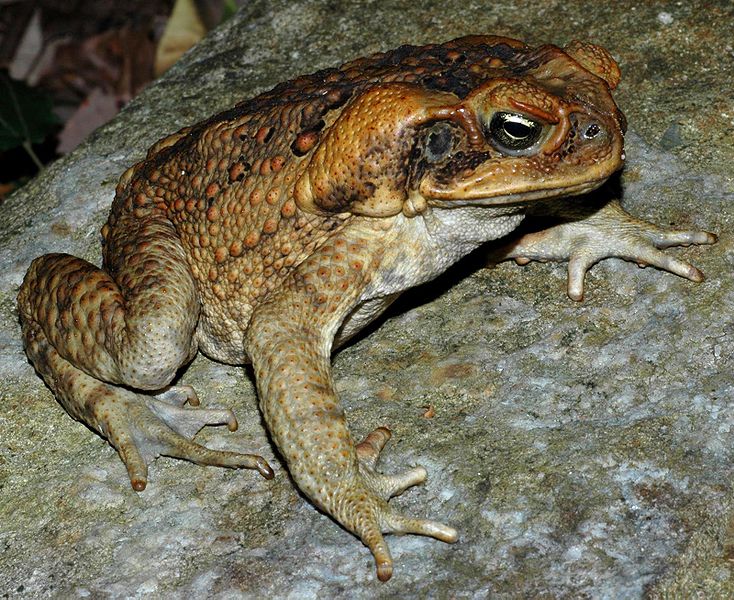Though the past three decades have seen dramatic declines in world amphibian populations, some amphibians--like the large and notoriously invasive cane toad, pictured here--are still going great guns. (Read more about frogs lost & found.)
What makes these warty wonders such an evolutionary success story?
It helps that toads have been at it a long time--they predate dinosaurs. Over 35 million years ago, amphibians (a class that includes frogs, toads, and salamanders) were the first group of vertebrates to climb up onto dry land, and they've lived a dual life ever since, at home (to varying degrees, depending on the species) in both aquatic and terrestrial environments. (Want to see the differences between frogs and toads?)
The word amphibian, in fact, suggests that double life (amphi- means "on both sides" and bios means "life"). These ectothermic (cold-blooded) animals usually metamorphose from a juvenile water-breathing form to an adult air-breathing form.
Toads (Bufonidae) originated in the South American tropics, but it wasn't long (in evolutionary terms) before they'd spread to all continents except Australia and Antarctica. Cane toads were introduced into Australia in 1935 in the hopes that they would eat the beetles endangering the sugar cane crop. But although 62,000 toadlets were released on the formerly toad-free island continent, the amphibians didn't eradicate the beetles. They did, however, permanently alter Australia's ecosystem, spreading diseases that have affected local biodiversity. There are now over 200 million cane toads in Australia.
"Some amphibian groups are distributed all over the world, and others are not," says evolutionary biologist Ines Van Bocxlaer of Belgium's Vrije Universiteit Brussel. Harlequin toads, for example, have such a narrow habitat (the rainforests of Costa Rica and Panama) that they are vulnerable to extinction. Other toads are globetrotters, happily adapting to new environments and often squeezing out native populations.
Earlier this year, Van Bocxlaer and her team decided to study the traits that allowed toads to succeed, which in the animal world means to proliferate over large areas. The researchers narrowed down their list down to seven habits of effective toads:
1. dry land's just fine
Toads originated in the tropics, and at first required constant water and humidity (most frogs still need those conditions, one reason that more frogs seem to become extinct than toads). When some species became able to live in drier habitats, they expanded to other areas. Check out Howtosmile's Toad Abode hands-on activity to teach kids what makes a good home for a toad.
2. bigger is better
Bigger toads have a greater volume to hold onto water and relatively less surface area from which they lose moisture. This means they can live in a wider range of habitats, including drier ones than before.
3. lumpy is lovely
Toads have large bulbous lumps behind their eyes called parotoid glands. These sacs often contain poisons called bufotoxins, which help protect the toad from predators.
4. the good fat
Toads have a special type of body fat that lets them store more fat and hold onto extra energy reserves. "More energy enables you to travel over longer distances," Van Bocxlaer said.
5. born in a mud puddle
Way back when, toads needed to lay their eggs in very specific bodies of water at very specific temperature. Then they evolved to be able to lay their eggs in all sorts of water, including temporary puddles.
6. the more eggs the better
When toads began to produce large clutches of thousands of eggs (rather than just a few that needed special maternal care), they were able to travel more easily and disperse farther.
7. mom is not mandatory
Some toad larvae feed off of nutrients from their mother (these are called endotophous), but exotrophous larvae feed off nutrients from their environment. Since exotrophous larvae don't suck mom dry of resources, toads with this trait can have more young that can then take up residence all over the place.
Photo of cane toad courtesy of Wikipedia

